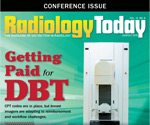 |
Typically when you attend the AHRA annual meeting, you hear a fair amount of radiologist bashing. Similarly, when you attend radiologist meetings, you tend to hear similar hospital criticism. Much of that is just human nature, the standoffish nature of “us vs them.”
But there was a different vibe at AHRA’s 2015 annual meeting that wound its way through several sessions: Hospitals and radiology groups are recognizing a need to greatly improve their efforts at working together for the benefit of both, despite their history of not doing so.
— Jim Knaub, editor |
 |
 |
Health Care Is a Team Sport
By Jim Knaub
Douglas G. Smith, FRBMA, calls health care a team sport. He makes an excellent point. Speaking at AHRA’s 2015 annual meeting last month, the managing partner of Integrated Medical Partners said radiology groups and hospital imaging departments should recognize that they’re on same team—despite their mutual tradition of too often not seeing it that way.
“We need [hospitals and radiology groups] to work as partners,” Smith said. “There are things that hospitals understand about what’s happening with populations and patients that the physicians don’t. There are things that physicians know that hospitals don’t have any visibility of—why don’t we share that together? Why don’t we manage this right to all our benefit?”
As health care starts a migration from predominantly fee-for-service reimbursement, through bundled reimbursement, toward value- and merit-based models where providers bear much greater financial risk, Smith sees both hospitals and radiologists benefitting from greater alignment of their shared purpose of delivering high-value imaging care. The days are over when every group in health care can cut their own generous slice out of a large, rapidly growing health care pie.
Full story » |
 |
 |
Biopsy & Treatment
A recent study looks at combining lung cancer biopsy and radiofrequency ablation into one procedure as a way to both alleviate patient stress and reduce possible complications from multiple invasive procedures. Read more »
Desk Job
Radiologists put in long hours at their workstations, which can put them in uncomfortable positions. To alleviate some of this physical stress, considerations such as comfort, quality, size, and functionality should be top of mind when shopping for furniture for the radiology reading room. Read more »
Getting Paid for DBT
Digital breast tomosynthesis is gaining acceptance in women’s imaging. However, imagers have had to deal with the challenges of sporadic reimbursement from insurance providers who still view the procedure as experimental. Read more »
Archive Strategies
As health care organizations seek ways to make medical images accessible throughout their enterprises, many are looking at their archives as a starting point. Health systems consolidation combined with rising demand for imaging is making an effective archiving strategy essential. Read more » |
 |
|
|
 |
“We currently do not have effective treatments for Alzheimer's disease, so the focus is on prevention. In the future, we may be able to provide patients with useful and actionable information about the impact different risk factors may be having on their brain health during routine clinical imaging. And since no special imaging equipment is needed, there is a great potential to provide this service at many centers across the country.”
— Kevin S. King, MD, an assistant professor of radiology at the Keck School of Medicine of the University of Southern California in Los Angeles, speaking on the results of an MRI study that found specific cardiovascular risk factors may predict Alzheimer’s disease |
 |
|
